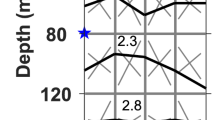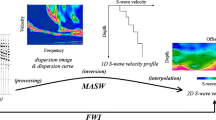Abstract
Imaging of small-scale heterogeneities is important for the geological exploration in complex environments. It requires a processing sequence tuned to high-resolution model building. Conventional methods which use refractions or reflections might face problems in resolving small-scale features since they are visually close to the resolution of the reflection images. Additional information or an unconventional technology, which supports the reflection imaging, is thus of great interest. An unconventional method based on seismic diffractions naturally complements specular reflection imaging. Diffracted waves represent a direct seismic response from small-scale subsurface heterogeneities, such as inclusions with a characteristic size of the prevailing wavelength, or discontinuities in geological interfaces, such as faults and fractures. We investigate the rule of diffracted part of the wavefield on velocity model building using a full-waveform inversion (FWI) example. In order to best acknowledge refracted and reflected parts of the wavefield in FWI, we chose a synthetic data example which mimics the ocean-bottom nodes acquisition survey as it provides almost perfect conditions for FWI of diving waves, a standard tool for high-resolution model building. We show, that FWI using diving waves produces a well-resolved anomaly. Including other part of the wavefield, reflected waves, further improves the resolution of the velocity anomaly but also leads to a gentle overfitting due to missing illumination from the very steep anomaly flanks. Considering diffracted events in FWI improves the model resolution even further resulting in a detailed velocity model and correctly imaged anomaly in both vertical and lateral directions.
Similar content being viewed by others
References
Bauer A., Schwarz B. and Gajewski D., 2017. Utilizing diffractions in wave-front tomography. Geophysics, 82, R65–R73.
Billette F. and Lambaré G., 1998. Velocity macro-model estimation by stereotomography. Geophys. J. Int., 135, 671–680.
Bleistein N., 1984. Mathematical Methods for Wave Phenomena. Academic Press Inc., New York.
Broyden C.G., 1970. The convergence of a class of double-rank minimization algorithms. J. Inst. Math. Appl., 6, 76–90.
Dell S. and Gajewski D., 2011. Common-reflection-surface-based workflow for diffraction imaging. Geophysics, 76, S187–S195.
Grion S., Exley R., Manin M., Miao X., Pica A.L., Wang Y., Granger P. and Ronen S., 2007. Mirror imaging of OBS data. First Break, 25, 37–42.
Khaidukov V., Landa E. and Moser T.J., 2004. Diffraction imaging by focusing-defocusing: An outlook on seismic superresolution. Geophysics, 69, 1478–1490.
Klem-Musatov K., 1994. Theory of Seismic Diffractions. Society of Exploration Geophysicists, Tulsa, OK.
Kosloff D., Queiroz Filho A., Tessmer E. and Behle A., 1989. Numerical solution of the acoustic and elastic wave equations by a new rapid expansion method. Geophys. Prospect., 37, 383–394.
Lambaré G., Virieux J., Madariaga R. and Jin S., 1992. Iterative asymptotic inversion in the acoustic approximation. Geophysics, 57, 1138–1154.
Leung S. and Qian J., 2006. An adjoint state method for three-dimensional transmission traveltime tomography using first-arrivals. Commun. Math. Sci., 4, 249–266.
Pestana R. and Stoffa P.L., 2009. Rapid expansion method (REM) for time-stepping in reverse time migration (RTM). SEG Technical Program Expanded Abstracts, 28, 2819–2823.
Plessix R.E., 2006. A review of the adjoint-state method for computing the gradient of a functional with geophysical applications. Geophys. J. Int., 167, 495–503.
Chen S.-C. and Zhou H.-M., 2016. Re-exploration into migration of seismic data. Chinese J. Geophys., 59, 54–67, DOI: https://doi.org/10.1002/cjg2.20213.
Trad D., 2011. Five-dimensional interpolation: Recovering from acquisition constraints. Geophysics, 74, V123–V132.
Tsai Y.H.R., Cheng L.T., Osher S. and Zhao H.K., 2003. Fast sweeping algorithms for a class of Hamilton-Jacobi equations. SIAM J. Numer. Anal., 41, 673–694.
Virieux J. and Operto S., 2009. An overview of full-waveform inversion in exploration geophysics. Geophysics, 74, WC11–W26.
Vogel C.R., 2002. Computational Methods for Inverse Problems. Frontiers in Applied Mathematics 23. SIAM, Philadelphia, PA.
Wang G.C., Wang S.X., Song J.Y., Dong C.H. and Zhang M.Q., 2018. Elastic reflection traveltime inversion with decoupled wave equation. Geophysics, 83, R463–R474, DOI: https://doi.org/10.1190/geo2017-0631.1.
Warner M., Ratcliffe A., Nangoo T., Morgan J., Umpleby A., Shah N., Vinje V., Stekl I., Guasch L., Win C., Conroy G. and Bertrand A., 2013. Anisotropic 3D full-waveform inversion. Geophysics, 78, R59–R80.
Wu R.-S. and Nafı Toksöz M., 1987. Diffraction tomography and multi-source holography applied to seismic imaging. Geophysics, 52, 11–25,. DOI: https://doi.org/10.1190/1.1442237.
Xie Y. and Gajewski D., 2017. 5-D interpolation with wave-front attributes. Geophys. J. Int., 211, 897–919.
Yuan S.Y., Wang S.X., Luo Y.N., Wei W.W. and Wang G.C., 2019. Impedance inversion by using the low-frequency full-waveform inversion result as an a priori model. Geophysics, 84, R149–R164, DOI: https://doi.org/10.1190/geo2017-0643.1.
Zhao H.R., 2004. A fast sweeping method for eikonal equations. Math. Comput., 74, 603–627.
Znak P., Kashtan B. and Gajewski D., 2018. Velocity model building by geometrical spreading focusing. SEG Technical Program Expanded Abstracts 2018, 5188–5192, DOI: https://doi.org/10.1190/segam2018-2997331.1.
Acknowledgements
We would like to thank members of the Applied Seismic Group, University of Hamburg, and Applied and Earthquake Seismology Group, FU Berlin, for helpful discussions.
Author information
Authors and Affiliations
Corresponding author
Rights and permissions
About this article
Cite this article
Dell, S., Abakumov, I., Znak, P. et al. On the role of diffractions in velocity model building: a full-waveform inversion example. Stud Geophys Geod 63, 538–553 (2019). https://doi.org/10.1007/s11200-019-0733-6
Received:
Revised:
Accepted:
Published:
Issue Date:
DOI: https://doi.org/10.1007/s11200-019-0733-6




